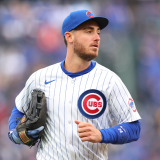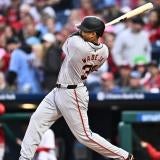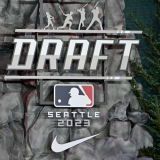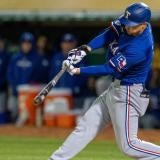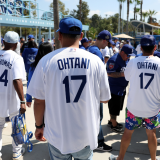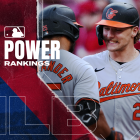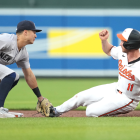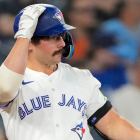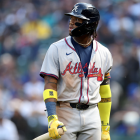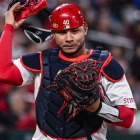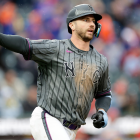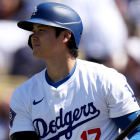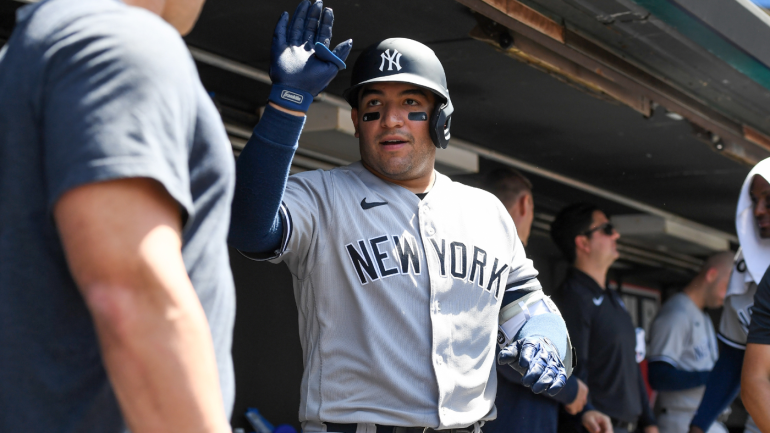
Major League Baseball's trade deadline, scheduled for Aug. 2 instead of July 31 this year, is now less than three weeks away. Business, then, should start to pick up any day now. (CBS Sports recently released its rankings of the summer's top 30 trade candidates in preparation.) While everyone's attention is always on the headline-grabbing trades, this season has provided numerous reminders of how important smaller transactions can prove to be over the long haul.
To wit, below you'll find five players who were acquired since the end of last season in otherwise forgettable fashion -- be it a minor trade, a waiver claim, what have you -- and who have since provided their teams with major returns on investment. Do note that the players are presented in order of their Wins Above Replacement total, and that there are more than five players who were in consideration for this piece.
1. Jose Trevino, C, New York Yankees (2.1 WAR)
The Yankees acquired Trevino from the Rangers less than a week before Opening Day in exchange for pitchers Albert Abreu and Robby Ahlstrom. (Abreu has since rejoined the Yankees off waivers after poor stints in Texas and Kansas City.) He'd fallen victim to a numbers game in Texas, where the Rangers had traded for Mitch Garver and preferred Jonah Heim as their backup. (And to be fair, Heim has performed this season, to the extent that Garver was bumped to DH before suffering an injury.)
While Trevino had a reputation for being a good defender, he'd seldom offered much value at the plate. Indeed, his career OPS+ entering this season was 69 and he'd launched just nine home runs in some 156 career big-league games. Naturally, he's hit for a 108 OPS+ and he's slugged seven home runs in his first 60 games in pinstripes en route to leapfrogging Kyle Higashioka on the depth chart. Last weekend, he was named to his first career All-Star Game, capping a highly unlikely ascent.
Jose Trevino doing it behind and at the plate 💪 pic.twitter.com/1vnkmFR9IP
— YES Network (@YESNetwork) June 12, 2022
What's changed? Trevino's philosophy at the plate. He's hitting the ball about a mile per hour harder year-to-year, but the biggest difference is where and how he's hitting it; both his pull and his fly-ball percentages have increased, with the latter moving from 32.6 percent to 40 percent. He's made a habit of getting his barrel out and pulling inside pitches, with all but one of his home runs exiting to left or left-center. His eagerness to lift the ball has led to an increase in pop-ups, which has amusingly left him with a shorter average fly-ball distance than he had in either 2021 or 2020. It doesn't matter, though, since he's making the ones he hits a long way count more.
Whether or not Trevino can sustain this level of production the rest of the way is irrelevant. He's already given the Yankees more than they expected. Besides, if Trevino slips, they have some additional help on the way in the form of Ben Rortvedt, another spring trade acquisition who has yet to play in the majors this season because of injury.
2. Cionel Pérez, LHP, Baltimore Orioles (1.8 WAR)
Pérez used to be an undersized starting pitching prospect with the Houston Astros. Injuries did in his chances of ever cracking their roster, however, and he was later shipped off to Cincinnati in a small trade. Pérez threw 24 innings for the Reds last season, walking 20 batters in the process and earning himself his walking papers. The Orioles, guided by some of his old Houston bosses, claimed him off waivers in November and he's since become a standout member of their bullpen, amassing a 0.90 ERA and a 2.45 strikeout-to-walk ratio in his first 30 frames this season.
Pérez relies on two pitches, a mid-to-upper 90s fastball and a low-80s slider. The former benefits from his smaller stature, as the vertical break in combination with his flat release point creates a more devastating optical illusion up in the zone. The latter offers a ton of depth: his minus-5.1 inches of induced vertical break ranks in the second percentile among pitchers with at least 50 sliders thrown this season. That helps to explain why Pérez has a grounder rate north of 50 percent.
3. Harold Ramírez, OF/DH/1B, Tampa Bay Rays (1.3 WAR)
Ramírez had changed hands on two occasions in 2021, so it wasn't overly notable when the Rays traded a minor-league infielder for him in March. He's since imparted greater significance to that deal by hitting .332/.378/.450 (144 OPS+) in 74 games.
LET'S GO!
— Bally Sports Florida & Bally Sports Sun (@BallySportsFL) July 9, 2022
Harold Ramírez drives in 2 runs in the 8th to give the @RaysBaseball a 3-0 lead! #RaysUp action ➡️ https://t.co/ZNJgBObHDs pic.twitter.com/ObqQkMqTA4
Ramírez comes from the Yandy Díaz school of hitting, which is to say he's a pure contact hitter whose top-end exit velocities hint at brilliant power just under the surface -- power that he seldom taps into because his average launch angles are in the single digits. That hasn't stopped either from producing, so fair enough.
Ramírez has contributed against righties and lefties alike, but he's been otherworldly versus the latter: in 79 plate appearances, he's hit .371/.443/.471 with almost as many walks (eight) as strikeouts (nine). The Rays have been without several of their top hitters for large swaths of the season; Ramírez has helped keep them afloat.
4. Jorge Alfaro, C, San Diego Padres (0.9 WAR)
Padres general manager A.J. Preller used to be a top-ranking member of the Rangers scouting department. That helps to explain why he's so willing to give second (or third) chances to former Texas prospects, including the likes of Jurickson Profar, Nomar Mazara, and Alfaro. (To think, that's just on the hitting side of things.)
Alfaro is meant for walk-off moments 💥@Padres | #TimeToShine pic.twitter.com/E0NAfs37YZ
— Bally Sports San Diego (@BallySportsSD) July 8, 2022
Alfaro, purchased from the Miami Marlins last December, receives the spotlight here after hitting .268/.300/.430 (111 OPS+) with six home runs in 53 games. He's always shown impressive tools: big raw power; an elite arm; far better speed than the average catcher; and so on. He's tapped into some more of that this season by upping his launch angle to a career-high 8.8 degrees and posting a career-high pull rate.
Alfaro's game still has some warts: he's a threat to post the ugliest strikeout-to-walk ratio on his team in any given season, and he's not a skilled framer … but the Padres have to be thrilled with how their gamble has worked out to date.
5. Yency Almonte, RHP, Los Angeles Dodgers (0.9 WAR)
Almonte spent parts of four seasons in the Rockies bullpen, where he compiled a 5.30 ERA in 124 innings pitched. He signed a minor-league pact with the Dodgers in March and -- much to Colorado's chagrin -- he's since emerged as a big-time contributor with seasonal marks that include a 1.46 ERA and a 3.00 strikeout-to-walk ratio.
Yency Almonte with the nutmeg. 🤭 pic.twitter.com/dMHsGVlJgx
— SportsNet LA (@SportsNetLA) May 15, 2022
In the Rockies' defense, the Dodgers helped Almonte overhaul his arsenal. He ditched his four-seamer for a two-seamer, and he started to throw a "sweeper" in place of his older slider. He's also ratcheted up his breaking ball usage, to the extent that it's his primary pitch. That kind of responsibility hasn't reduced his sweeper's effectiveness, as it's still sporting a 56 percent whiff rate. Almonte's new one-two punch combination has allowed him to coerce an average exit velocity of 82 mph, or the second-lowest in the majors among pitchers with at least 20 innings thrown.
Almonte is a fitting reminder that sometimes a player just needs to find the right system in order for them to maximize their talent.








